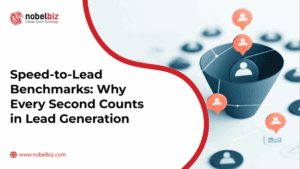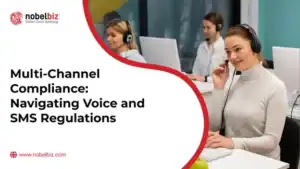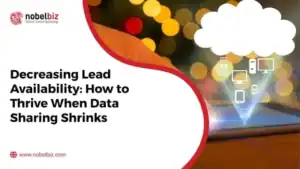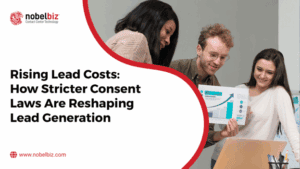In 2025, where automation and AI are rewriting what “fast” means, speed-to-lead is a mindset. Call center speed-to-lead defines who connects first and who gets left behind. It describes how efficiently your contact center turns inbound curiosity into outbound conversation, and conversations into revenue.
- Speed-to-lead is a critical success factor: in modern call centers.
- Delays in outbound and inbound lead handling: result in measurable revenue loss.
- AI and automation: are essential to achieving real-time lead response.
- Monitoring key metrics: is necessary to drive continuous improvement.
- NobelBiz OMNI+: enhances speed-to-lead performance through integrated automation.
How many leads are slipping through your fingers because your team didn’t call fast enough?
In call centers, seconds don’t just count; they close deals.
That’s not an exaggeration. In today’s on-demand world, the first company to respond often wins the customer. Studies show that leads contacted within five minutes are nine times more likely to convert than those reached after 30 minutes.
Yet, most call centers still take over 30 minutes to make first contact, long enough for interest to fade or a competitor to jump in.
Think about that for a second. Your agents, your systems, and your strategy are all working hard, but a few minutes' delay can undo it all. The lead that filled out your form with real intent? They’ve already been called, quoted, and maybe even signed by someone else.
This blog breaks down what speed-to-lead in contact centers really means for modern call centers, how to measure it, compare it against contact center speed-to-lead benchmarks, and optimize it with automation. It also explores which tools and best practices can help your team stay ahead.
Because in this business, it’s not the biggest call center that wins. It’s the fastest one.
“In call centers, seconds don’t just count, they close deals. Every extra minute you wait, your competitors are already talking to your lead.”- Christian Montes, Chief Operating Officer at NobelBiz
What Speed-to-Lead Means for Call Centers?
Call Center Response Time Benchmarks You Need to Know in 2025
Think your team is fast? This side-by-side breakdown shows how timing impacts conversion, and where your call center may be falling short.
| Response Time | Conversion Impact | Benchmark Insight (2025) |
|---|---|---|
| 1–5 minutes | 7–9× higher conversion | Outbound contact centers converting 100× more effectively |
| 5–10 minutes | Declining performance | Drop-off begins after 5 minutes |
| 10–60 minutes | Sharp decline | Telecom & BPO average: ~16 min |
| 1–24 hours | Leads mostly cold | Industry average: ~42 hours |
| 24+ hours | <10% conversion chance | 38% of leads were never contacted |
2025 Speed-to-Lead Benchmarks for Contact Centers
Here’s how speed-to-lead benchmarks for contact centers are raising the bar and what “fast” really looks like across today’s top-performing industries.
Every industry defines “fast” a little differently, but one thing’s constant: speed wins. Here’s what 2025 benchmarks are showing across key sectors:
Response Time Benchmarks Across Industries (Finance, SaaS, Healthcare, Telecom)
- Finance: Average first response time is under 2 minutes. Financial leads expect urgency; they’re often comparing rates or offers in real time.
- SaaS: Most software companies aim for 5 minutes or less, though top performers respond in under 60 seconds using automated routing.
- Healthcare: Still catching up, with average response times around 10–15 minutes, mainly due to compliance and staff availability.
- Telecom: With high competition and short decision cycles, best-in-class contact centers respond in under 90 seconds.
The bar keeps dropping. What used to be “impressive” is now just expected. The faster your team connects, the more leads you own before they move on.
Comparing industry benchmarks for call center response time helps teams see where they stand and how much faster they need to move to stay competitive.
Why B2B Outbound Contact Centers Struggle with Response Latency?
B2B outbound contact centers face a more formidable challenge, not because they don’t value speed, but because complexity slows them down.
When reps wait for assignments, minutes disappear. CRMs, dialers, and lead forms that don’t sync in real time create bottlenecks. B2B leads often require research before outreach, but that research eats into response time.
78% of buyers convert with the first responder. That means being second, even by a few minutes, often means being too late. Speed is a sales advantage. If your systems make your reps wait, your competitors won’t.
How SLA Discipline Separates High-Performing Contact Centers?
Service Level Agreements (SLAs) sound boring until they start saving deals. In contact centers, SLA discipline is what turns “we try to be fast” into “we are fast.”
What SLA discipline looks like:
- Clear targets (e.g., “all new leads contacted within 60 seconds”).
- Live dashboards showing average response time per agent or team.
- Automatic alerts when response time breaches limits.
One healthcare center, for instance, introduced a 90-second SLA on inbound patient inquiries. Within three weeks, their connect rate jumped by 40%. They started tracking every second and holding teams accountable.
Without SLAs, speed goals are just wishes. With SLAs, speed becomes culture. The best contact centers don’t just chase leads faster; they measure, monitor, and maintain that speed every day.
Why does your team follow up, but still lose the deal? Here’s what speed-to-lead really means and why it could be the reason your competitors keep closing first.
Speed-to-lead is the time it takes for your team to contact a new lead after they show interest — for example, by filling out a form or responding to a campaign. In outbound or blended call centers, it’s the difference between reaching a motivated lead and chasing a cold one. Speed-to-lead automation in contact centers helps ensure every new inquiry is routed to the right agent instantly.
Speed-to-Lead in Outbound and Blended Environments
- Leads cool down fast, sometimes within minutes.
- The sooner you call, the higher your chances of connecting and converting.
- Every extra minute lowers the odds of reaching the lead live.
In a blended setup, aligning your outbound and inbound teams around a single goal — responding fast — is what keeps leads warm and opportunities alive.
Why Speed Defines Conversion Rate, Connect Rate, and Revenue
Speed-to-lead doesn’t just improve response time; it improves overall efficiency and directly affects how much revenue your call center generates. Here’s how:
- Conversion rate: The faster you respond, the more likely the lead is to remember who you are and say yes.
- Connect rate: A quick call means the lead is still by their phone or computer, ready to talk.
- Revenue: More connections lead to more conversations — and conversations lead to sales.
Speed doesn’t just improve metrics; it multiplies outcomes. The gap between “fast” and “slow” can amount to thousands in lost revenue. A fast response improves your connect rate improvement strategies, directly influencing overall conversion and revenue.
The 5-Minute Rule and Its Application to High-Volume Call Centers
The 5-minute rule is simple: reach out within five minutes of receiving a lead. After that, your odds drop sharply. But in high-volume call centers, that’s easier said than done. Hundreds of leads pour in daily. Here’s how you can manage it:
- Prioritize automation: Utilize CRM triggers to alert reps instantly when a new lead arrives.
- Use smart routing: Send leads to the next available rep, not the next one in line.
- Measure average response time: Track how close your team stays to that 5-minute mark.
For instance, two call centers receive 1,000 leads. One contacts each within 3 minutes; the other waits 30 minutes. The first center could see up to 10× more conversions without changing anything else.
The 5-minute rule isn’t just best practice; it’s a revenue safeguard. Every delay beyond it costs real dollars.
Why “Seconds to Response” Is the New Call Center KPI
Five minutes used to be fast. Today, it’s just average. In high-performance call centers, seconds now define success.
Customers expect instant answers. If you don’t respond, someone else will. AI dialers, lead routing, and automation enable sub-minute response times. “Seconds to response” shows how close you are to real-time engagement — and real-time revenue.
Imagine a lead filling out a quote form. You call them 20 seconds later — they’re surprised, but impressed. You catch them before they move on or get distracted. That moment defines modern call center excellence.
How to get there:
- Integrate lead capture tools directly with your dialer or CRM.
- Use AI to predict rep availability and assign leads instantly.
- Display “seconds-to-response” on dashboards so every agent sees it live.
Speed defines success in the modern call center — every second counts, and automation is the key to winning every lead.
Salman Aslam
Director Support – Quality & Training at WORK Inc.
‘The support team at Nobelbiz understood our business requirements and we we’re able to push through seamlessly’
The Cost of Delay in Outbound and Inbound Lead Handling
Whether it’s an outbound follow-up that took too long or an inbound call no one picked up fast enough, every delay costs you in lost conversations, cold leads, and missed revenue.
Most of these losses don’t show up on reports; they just quietly eat away at your results. Let’s break down where these delays really happen, and what they’re costing your contact center.
How Delayed Follow-Up Kills Connect Rate and Revenue?
Every second you wait, your lead cools down.
When follow-up drags on, your connection rate drops quickly. A lead that’s ready to talk at minute one might ignore you completely at minute ten. The longer the gap, the harder it gets to reach them and the less likely they are to remember who you are.
The lead has already moved on to another brand or task. By the time you call, they’ve lost interest or forgotten why they reached out. Those missed connections accumulate over days and weeks, resulting in thousands of unrealized sales.
Every delayed follow-up impacts your speed-to-lead performance, which in turn lowers conversions and customer satisfaction.
When “Warm” Leads Turn Cold: Psychological and Operational Impact?
Leads go cold fast. Not because they change their mind, but because the moment changes.
For instance, if someone fills out a form or clicks “Request a Demo,” they’re mentally ready. They want to solve a problem now. Wait too long, and that urgency fades. From a psychological view:
- Attention shifts — the lead gets back to their inbox or another task.
- Trust drops — if you’re slow to respond now, they assume you’ll be slow later too.
- Momentum dies — what was once excitement becomes hesitation.
Operationally, it’s a double hit. Your reps waste time chasing leads that have already gone cold. Your pipeline looks full, but the quality inside it is slipping.
Knowing how fast call centers should respond to inbound leads is key; even a 10-minute delay can reduce conversions by 80%. “Warm” leads don’t stay warm. You either catch them in the moment or you let that moment go.
How Competitors Capitalize When Your Agents Respond Too Slowly?
If you don’t call first, someone else will. Competitors love slow responders because they make winning easy.
Consider a situation: A prospect fills out multiple forms, yours and those of your competitor. Their phone rings within two minutes, and it’s not you. The competitor starts the conversation, books the meeting, and closes the deal.
You might call five minutes later, but at that point, the door’s already closed. From the lead’s perspective, they’ve “started the process” with someone else. Why restart it with you? This is where top-performing contact centers stand out:
- They have instant routing and no manual steps, no waiting.
- They measure seconds-to-response, not minutes.
- They treat speed as strategy, not luck.
Technology and Automation That Accelerate Lead Response
Automation is now the backbone of speed-to-lead automation for contact centers. Here’s how top contact centers are closing the speed gap with the help of smart tools and automation.
If you’re an ops or sales leader, the good news: it’s about systems, not hand-wringing. You can take control of response times today.
How AI-Powered Routing and Auto-Dialers Improve Response Time?
Slow lead distribution and manual dialing cost you minutes and leads. When a lead arrives and sits unassigned, the window of opportunity shrinks. Manual dialing means agents wait between calls, wasting time.
This is where lead response time optimization in call centers truly scales. AI takes over repetitive routing while agents focus on conversations.
- Auto-dialers initiate outbound calls and immediately connect the lead to an available agent.
- AI- or rule-based routing assigns leads based on rep availability, skill, or priority.
- For example, NobelBiz OMNI+ offers predictive, progressive, and preview dialers. With automation, your reps spend more time talking and less time waiting.
Use auto-dialing and smart routing to ensure leads are contacted while they’re hot, not after the window has closed.
How NobelBiz’s OMNI+ Platform Automates Inbound-to-Outbound Callbacks?
You get an inbound lead (e.g., a web form or chat) and want to follow up immediately, but your inbound team is busy.
However, inbound teams may handle the initial touchpoint, but follow-up outbound gets delayed or fragmented. That delay weakens the lead’s motivation and trust.
NobelBiz OMNI+ supports inbound voice triggers with skill-based routing, IVR, CTI, and other tools. It can automatically enqueue callback tasks from inbound channels and send those to the outbound module without manual hand-off. That means the moment a lead requests help (inbound), your outbound workflow begins with no pause, no extra queue.
For instance, your website visitor fills out a “Call me back” form at 3:02 pm. The inbound system spots it, creates the callback in OMNI+, and sends it to the next outbound dialer. By 3:04 pm, your agent is on the line, instead of the lead drifting off to another vendor.
Platforms like NobelBiz OMNI+ bridge inbound and outbound. That continuity means fewer “warm leads” turning cold during handover.
The Role of NobelBiz OMNI+ in Ensuring Visibility and Deliverability
It’s not enough to move fast. You also need to see how fast and prove delivery quality.
Without complete visibility, you don’t know which leads were contacted, who responded, or when. Voice-delivery issues (dropped calls, blocked numbers, poor quality) silently kill performance. NobelBiz OMNI+ features that help:
- Unified dashboards for inbound and outbound campaigns, showing KPIs in real time.
- Built-in voice-carrier network explicitly designed for call-center traffic, reducing dropped calls and number labeling.
- Single-tenant, dedicated infrastructure means your data and delivery are not shared or compromised.
This helps you spot delays in real-time and intervene. Calls reach the lead rather than getting hung up on or blocked.
CRM, IVR, and Analytics Integrations for Instant Agent Assignment
Managing leads and routing them manually can be time-consuming and slow you down. Connected systems speed you up.
Leads are logged in one system, dialed in another, and tracked in yet another, resulting in numerous handoffs and delays. Agents without context waste time figuring out who the lead is and what they did.
- IVR captures inbound lead details and feeds them into the CRM. With OMNI+, IVR, CTI, TTS, and speech recognition are built in.
- The CRM syncs with OMNI+, so when a lead comes in, the next available agent appears with a complete history across all channels.
- Analytics feed into campaign dashboards, so you can see what’s working and adjust routing rules on the fly.
For example, a SaaS prospect starts with a chat question. They then fill out a web form. The system logs the form, routes to the best agent for that product, and assigns the callback immediately, with no manual triage.
Integration means leads are responded to by the right person, right away. That drives both speed and effectiveness.
Real-Time Alerts to Eliminate Missed Opportunities
You can’t fix what you don’t monitor. Real-time alerts change the game. A burst of leads comes in; your capacity lags, unnoticed. A campaign underperforms, but you find out hours or days later, too late. Agents get overloaded, and calls get delayed. Here is how behavior changes with alerts:
- Set triggers when response time exceeds your threshold (e.g., 60 seconds).
- The dashboard pops an alert, the manager reallocates resources, or the system reroutes leads.
- OMNI+ supports real-time KPI monitoring and alerts across channels.
Think of a racing pit stop: fuel level drops low, alarm sounds, crew jumps into action. In your call center, the alarm is an alert on the lead backlog, and the crew is your agent-routing or automation. Without that alert, you limp along and lose the race.
Build alerts into your workflow. When real-time transparency meets real-time response, you stop losing leads before you even know they were at risk.
Best Practices for Call Center Speed Optimization
Even with the best tech in place, speed depends on process and people. Here is the list of practices that help call centers stay consistent:
How to Set Internal SLAs That Align With Speed-to-Lead Benchmarks?
Speed starts with clarity. If you don’t define “fast,” your team won’t know what to aim for. Many contact centers rely on general goals, “call leads quickly,” but that’s too vague to drive accountability.
- Set time-bound SLAs for each lead type (for example, “All inbound web leads must be contacted within 60 seconds”).
- Align those SLAs with industry benchmarks — under 2 minutes for finance, under 5 for SaaS, under 90 seconds for telecom.
- Display live SLA dashboards so agents see where they stand.
- Review SLA compliance weekly, not quarterly.
Define, track, and live by your SLA. Fast becomes culture only when it’s measured daily.
Training Teams to React Fast Without Sacrificing Compliance
Reps hesitate to call quickly because they fear missing a required disclosure or mishandling data. That hesitation adds seconds, then minutes. Training that helps:
- Role-play “speed + accuracy.” Practice real calls under time limits while reinforcing compliance scripts.
- Simplify workflows. Fewer clicks mean fewer compliance errors.
- Use call scripts inside CRM pop-ups so agents can confirm disclosures while speaking.
- Coach in real time. Use call monitoring to reinforce good habits rather than retroactive correction.
Train for confidence. When agents trust their process, speed follows naturally. The proper training strikes a balance between quick outreach and compliance, reinforcing best practices for call center speed-to-lead.
Using Analytics to Measure Lead Response by Agent, Team, and Channel
You can’t improve what you don’t measure. Analytics turn “we think we’re fast” into “we know who’s fast.”
Below are the key metrics your team should monitor to understand and improve how quickly and effectively you're engaging new leads:
| Metric | What It Measures |
|---|---|
| Time-to-First-Contact | The time between when a lead is created and when your team first reaches out. |
| Response Distribution | Which agents or teams are consistently meeting your SLA goals for lead response? |
| Channel Performance | How do different channels (web, phone, chat) compare in terms of response speed? |
| Conversion Correlation | The relationship between how fast you respond and how often those leads convert. |
Visualize these metrics in heat maps, with red for slow and green for fast. Instant clarity drives ownership.
Use data to find the friction. The goal isn’t just to go faster, it’s to know where and why you slow down. Analytics uncover improvement strategies for the connect rate by tracking which channels and agents deliver the fastest responses.
How Blended Inbound-Outbound Workflows Reduce Delay?
Most centers treat inbound and outbound as separate worlds. That gap causes lost seconds and lost deals. Inbound teams capture leads but often hand them off manually to outbound reps. Each transfer adds delay and confusion.
- Use one unified queue where all leads, inbound or outbound, are visible.
- Equip agents to handle both directions, so calls can flip instantly from receiving to following up.
- Automate callbacks: when an inbound agent misses a call, it automatically routes to outbound agents within seconds.
- Track combined SLA metrics rather than separate ones.
Blending is about eliminating handoff lag. One system, one queue, one goal: respond fast. Blended workflows directly support speed-to-lead best practices for outbound campaigns, keeping momentum across every channel.
Clinical Trial Media
Mo Pene |
Contact Center Technology Manager @ CTM
‘Thanks to NobelBiz, we now enjoy a robust, scalable communication system tailored to our growing needs, empowering us to deliver personalized care experiences more efficiently and boosting our overall revenue.’
Final Thoughts: Lead Speed = Lead Success
In today’s contact center speed-to-lead world, every second truly counts. The difference between a five-second and a fifty-second response isn’t just time; it’s trust, momentum, and revenue.
Your prospects expect real-time engagement, and when they don’t get it, they move on. As a leader, your role is to make sure your systems, teams, and goals reflect that urgency every single day.
Compliance, routing, and agent speed aren’t separate challenges; they’re pieces of one puzzle: operational excellence. The best contact centers design workflows that build compliance in, route automatically, and empower agents to act fast.
When speed becomes culture, not chaos, teams perform consistently, customers stay engaged, and conversions rise naturally.
Ultimately, the fastest teams win, not the loudest ones. You don’t need bigger budgets or flashier scripts; you need discipline, data, and decisive action.
When your contact center measures success in seconds and delivers every lead the moment it arrives, you’re not just keeping up with the competition—you’re leading it.
Accelerate Every Lead Response with NobelBiz OMNI+
Slow response times cost more than just leads; they cost trust and revenue. When your agents take minutes instead of seconds, competitors step in, and prospects move on.
The biggest challenge for today’s contact centers isn’t finding leads—it’s reaching them first.
NobelBiz OMNI+ changes that equation. The platform automates inbound-to-outbound callbacks in real time, ensuring every lead is contacted while their interest is still high. No manual routing. No lag. Just seamless speed, from the moment a form is filled to the moment your agent connects.
With built-in automation, intelligent lead generation, and real-time visibility, OMNI+ empowers your team to act instantly, stay compliant, and close faster.
Frequently Asked Questions
Discover how NobelBiz helps call centers maximize customer engagement, boost answer rates, and ensure compliance with industry-leading solutions.

Michael McGuire is a contact center industry expert with almost two decades of experience in the space. His experience includes roles as Director of Contact Center Digital Transformation at NobelBiz, and as Director of Operations at FLS Connect, managing multiple call centers. As President of Anomaly Squared and Targeted Metrics, Michael successfully transitioned companies into remote operations and significantly boosted revenues. With a strong background in customer service, leadership, strategic planning, and operations management, Michael excels in driving growth and innovation in the call center space.
Mike is also a proud Board Member for R.E.A.C.H Trade Group, promoting consumer protection and satisfaction and Co-host of the Off Skripted Podcast – a show about Life, Call Centers and everything in between.








